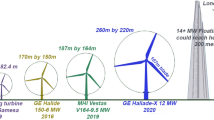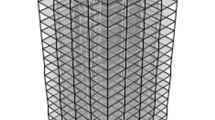Abstract
This paper deals with the performance of the modified environmental contour method (MECM) for determining long-term extreme load effect in a combined wind turbine and wave energy converter system. The wind turbine of the combined system is in the operational or parked mode depending on the wind speed. In addition, the wave energy converter in this study also experiences three modes depending on the significant wave height to reduce structural responses under extreme sea states. These features make the original environmental contour method (ECM) not applicable to the prediction of the long-term extreme of some responses. However, the MECM is suitable for analysis in such a system as it includes the effect of the changes of operational mode by considering additional environmental contours. It is found that the results of the MECM agree very well with the full long-term analysis (FLTA) which indicates that the MECM is applicable for such a system. In addition, the MECM can also be used to identify important environmental conditions to include in the reduced long-term analysis (RLTA), which is similar to FLTA but only includes selected environmental conditions that contribute to the relevant extreme responses.





















Similar content being viewed by others
References
Bachynski EE, Moan T (2013) Point absorber design for a combined wind and wave energy converter on a tension-leg support structure. In: Proceedings of the 32nd international conference on ocean, offshore and arctic engineering, , June 2013. vol 8. Nantes, France. https://doi.org/10.1115/OMAE2013-10429
Haver S, Winterstein S (2009) Environmental contour lines: a method for estimating long term extremes by a short term analysis. Trans Soc Naval Archit Marine Eng 116:116–127
Jonkman J, Butterfield S, Musial W, Scott G (2009) Definition of a 5-mw reference wind turbine for offshore system development. Technical report NREL/TP-500-38060, National Renewable Energy Laboratory. http://www.nrel.gov/wind/pdfs/38060.pdf
Karimirad M, Moan T (2012) A simplified method for coupled analysis of floating offshore wind turbines. Mar Struct 27(1):45–63
Li L, Gao Z, Moan T (2015) Joint distribution of environmental condition at five European offshore sites for design of combined wind and wave energy devices. J Offshore Mech Arct Eng 137(3):031901
Li Q, Gao Z, and Moan T (2013) Extreme response analysis for a jacket-type offshore wind turbine using environmental contour method. In: Proceedings of 11th international conference on structural safety and reliability, June 2013. New York
Li Q, Gao Z, Moan T (2016) Modified environmental contour method for predicting long-term extreme responses of bottom-fixed offshore wind turbines. Mar Struct 48:15–32
Lott S, Cheng PW (2016) Load extrapolations based on measurements from an offshore wind turbine at alpha ventus. J Phy: Conf Ser 753(7):072004. https://doi.org/10.1088/1742-6596/753/7/072004
Madsen HO (1988) Omission sensitivity factors. Struct Saf 5(1):35–45
MARINA (2014) EU FR7 MARINA PLATFORM: marine renewable integrated application platform. http://cordis.europa.eu/project/rcn/93425_en.html
Michailides C, Luan C, Gao Z, Moan T (2014) Effect of flap type wave energy converters on the response of a semi-submersible wind turbine in operational conditions. In: Proceedings of the 33rd international conference on ocean, offshore and arctic engineering, , June 2014. vol 9B. San Francisco. https://doi.org/10.1115/OMAE2014-24065
Muliawan M, Karimirad M, Moan T, Gao Z (2012) STC (spar-torus combination): a combined spar-type floating wind turbine and large point absorber floating wave energy converter promising and challenging. In: Proceedings of the 31st international conference on ocean, offshore and arctic engineering, , July 2012. vol 7. Rio de Janeiro p 667–676. https://doi.org/10.1115/OMAE2012-84272
Muliawan MJ, Karimirad M, Moan T (2013) Dynamic response and power performance of a combined spar-type floating wind turbine and coaxial floating wave energy converter. Renew Energy 50:47–57
Naess A, Moan T (2012) Stochastic dynamics of marine structures. Cambridge University Press, Cambridge
Peiffer A, Roddier D, Aubault A (2011) Design of a point absorber inside the windfloat structure. In: Proceedings of the 30th international conference on ocean, offshore and arctic engineering, June 2011. vol 5. Rotterdam p 247–255. https://doi.org/10.1115/OMAE2011-49015
Ren N, Gao Z, Moan T, Wan L (2015) Long-term performance estimation of the spartorus-combination (STC) system with different survival modes. Ocean Eng 108:716–728
Rendon EA, Manuel L (2014) Long-term loads for a monopile-supported offshore wind turbine. Wind Energy 17(2):209–223
Rosenblatt M (1952) Remarks on a multivariate transformation. Ann Math Stat 23(3):470–472
Saranyasoontorn K, Manuel L (2005) On assessing the accuracy of offshore wind turbine reliability-based design loads from the environmental contour method. Int J Offshore Polar Eng 15(2):132–140
Soulard T, Babarit A (2012) Numerical assessment of the mean power production of a combined wind and wave energy platform. In: Proceedings of the 31st international conference on ocean, offshore and arctic engineering, July 2012. vol 7. Rio de Janeiro p 413–423 https://doi.org/10.1115/OMAE2012-83606
Videiro PM, Moan T (1999) Efficient evaluation of long-term distributions. In: Proceedings of the 18th international conference on offshore mechanics and arctic engineering. St. Johns
Wan L, Gao Z, Moan T (2014) Model test of the STC concept in survival modes. In: Proceedings of the 33rd international conference on ocean, offshore and arctic engineering, number 45530, p V09AT09A010, Rotterdam, The Netherlands
Winterstein S, Ude T, Cornell C, Bjerager P, Haver S (1993) Environmental parameters for extreme response: inverse form with omission factors. In: Proceedings of the 6th international conference on structural safety and reliability, August 1993. Innsbruck
Acknowledgements
The authors gratefully acknowledge the financial support from the Research Council of Norway through the Centre for Ships and Ocean Structures and Centre for Autonomous Marine Operations and Systems at the Norwegian University of Science and Technology in Trondheim, Norway.
Author information
Authors and Affiliations
Corresponding author
Rights and permissions
About this article
Cite this article
Li, Q., Ren, N., Gao, Z. et al. Efficient determination of the long-term extreme responses by the modified environmental contour method for a combined wind turbine and wave energy converter system. J. Ocean Eng. Mar. Energy 4, 123–135 (2018). https://doi.org/10.1007/s40722-018-0111-4
Received:
Accepted:
Published:
Issue Date:
DOI: https://doi.org/10.1007/s40722-018-0111-4




